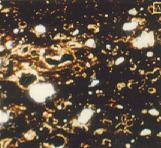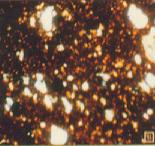 |
ARCHAEOMETRY OF AFRICAN AMPHORAE |
 |
ARCHAEOMETRY OF AFRICAN AMPHORAE |
Archaeometric research on amphorae sherds from the 1990-1 excavations coming from Libya (Tripolitana types) and Tunis ( Africana I and II types ) have allowed us to confirm the typological classification made by early archaeologists. However there is an exception in some sherds with no stamps. The lack of stamps and painted inscriptions (easily erased) on African amphorae has been a great problem for archaeologists.
The aim of archaeometric research is to separate the different typologies found at the Mount Testaccio by means of statistic clustering from chemical analyses. The latest results showed a difference between tunisian amphorae (less fired and more porous) and tripolitanian ones in an advanced state of vitrification, with total loss of primary calcites, presence of neoformation minerals (diopsites and galenites) which appear with temperatures over 800 ºC.
 A |
 B |
Picture of the
section of an african amphora seen trought polarised microscope.
Tunisian ones(A)
are more porous than tripolitan amphorae (B)
It's essential to use every typological group of stamps and inscriptions with a known origin as a reference to the chemical and mineralogical distinction. This allows to create reference groups for future research.
Mineralogic nature of ceramic mixture can be seen trough difractometric.
Porosimetric bend. Terraced bends are typical prow few porus material
and are similar to samples of tripolitan amphorae. Less terraced samples are from Bizacena amphorae.